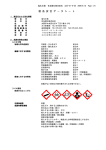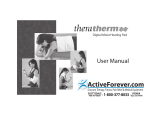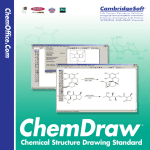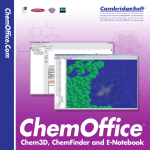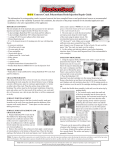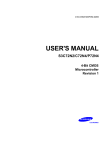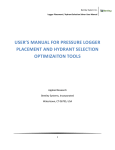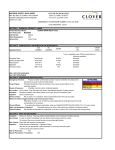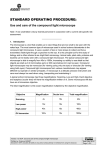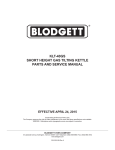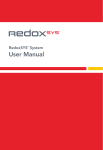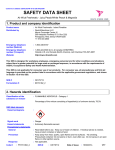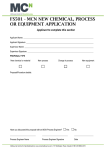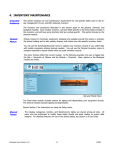Download "user manual"
Transcript
Material Safety Data Sheet Page 1 of 8 Section 1 - Product and Company Identification Product name ITO etch Other names Nitrohydrochloric acid; Royal water; Aqua Regia; Aqua Regalis, Nitrimuriatic Acid Product use Metallurgy; analyze metals and dissolve Pt, Au etc. Supplier's name San Fu Chemical Co., Ltd. Supplier's address 340 Hsiao Hsin Li, Shan-Hua District, Tainan City, Taiwan, R.O.C. Supplier’s phone 886-6-5837608 Emergency phone 886-6-5837608 FAX. 886-6-5839498 Section 2 - Hazards Identification Classification 1. Acute Toxicity Category 3 (Ingest) 2. Acute Toxicity Category 3 (Inhale) 3. Skin Corrosion/Irritation Category 1 4. Serious Eye Damage/Eye Irritation Category 1 5. Cause respiratory tract irritation Category 1 6. Specific target organ systemic toxicity-single exposure Category 1 7. Specific target organ systematic toxicity – repeated exposure Category 1 8. Hazardous to the aquatic environment (Acute) Category 1 The Most Important Hazards and effect Label element Hazard symbol Skull and Crossbones, Corrosion, Health Hazard, Environment Signal word Hazard statement: 1. 2. 3. 4. 5. 6. 7. 8. Danger Harmful if swallowed Harmful if inhaled Cause severe skin burns and eye damage Cause serious eye injury Inhalation May cause irritation of the respiratory tract with the symptoms of asthma or difficulty in breathing May cause organ injury (respiratory organs) Long term or repeated exposure may cause organ injury (teeth respiratory organs) Very toxic to aquatic organisms Precautionary statement 1. Read the user’s manual before operating 2. Do not inhale the gas/smoke/vapor/fog 3. Use personal protective gears and ventilation installation, avoid exposure to Material Safety Data Sheet 4. 5. 6. 7. Others Hazard -- Page 2 of 8 the substance Avoid eating and drinking while operating, and keep hygiene in working area Wear protective gloves, clothing, goggles Operate only in well-ventilated environment. Avoid releasing the substance into the environment without any treatment Section 3 - Composition/Information On Ingredients Mixture Chemical Property Component or impurities contributing Concentration or to the hazard concentration range Nitric acid 1~10% Hydrochloric acid 1~30% Water 1~60% CAS No. 7697-37-2 7647-01-0 7732-18-5 Section 4 - First Aid Measures The First-aid Information Inhalation 1. Remove the contaminated origin or move the patient to an air-circulated place. 2. If patient cannot breathe, provide CPR; if have difficulties breathing, provide oxygen. 3. Keep the patient warm and at rest. 4. Seek medical attention immediately Skin Contact 1. Avoid direct contact with the substance. If necessary, wear gloves. 2. Immediately flush skin with plenty of water for at least 20 – 30 min. 3. While washing, remove contaminated clothing, shoes and leather crafts. 4. Seek medical attention immediately. Eye Contact 1. Immediately flush eyes with plenty of water for at least 20 – 30 min, lifting eyelids occasionally. 2. Seek medical attention immediately. Ingestion 1. If patient is about to lose consciousness or already lost consciousness or having seizures, do not feed anything into the mouth. 2. Let patient gargle thoroughly using water. 3. Do not induce vomits. 4. If the patient has spontaneous vomits, incline the body to avoid ingest of the vomit. gargle repeatedly. 5. Seek medical attention immediately. The Most Important Symptoms and Hazardous Effects Highly corrosive and can cause fatal pulmonary edema, caused by burns or even blindness. Protection of First-aiders Material Safety Data Sheet Page 3 of 8 1. Staff without full body chemical-protective suit and mask should not enter the disaster area to carry the injured person. 2. Wear class C equipment to do first aid in a safety zone. Notes to a Physician 1. Patient, who inhaled the substance, should consider giving oxygen. 2. Avoid gastric lavage or induce vomit Section 5 - Fire Fighting Measures Extinguishing Media This is non-combustible material, select appropriate fire extinguishing agent according to the surroundings. Small fires: CO2, dry chemical or alcohol foam. Large fires: Water spray, alcohol foam. Specific Hazards when Fire-fight if contact with metal may produce hydrogen. Specific Fire-fighting Procedure: 1. Spray mist to cool down the containers that are exposed to the fire to avoid explosion. It will reduce or dissipate the vapor/steam. 2. If there is leak, do not spray water mist directly to the source of leak, trained personnel can neutralize the leak. Specific Protection of Firefighters To wear full-body chemical-protective suits and air breathing apparatus (if necessary, plus anti-Semitic fire coated aluminum jacket) Section 6 - Accidental Release Measures Personal Precautions 1. Isolate and restrict area access until clean up. 2. Ensure clean up is conducted by trained personnel only. 3. Must wear proper personal protection equipment. Environmental Precautions 1. Ventilate the area of leak. 2. Remove all source of ignition 3. Notify Government Safety and Environmental protection unit. Methods for Cleaning up 1. Avoid contact with spills. 2. Prevent from entering sewers or confined space. 3. If safe to do so, stop or reduce spills. 4. Use sand, soil or other agent that is non-reactive to the material to contain the leakage 5. Small spill: absorb with anything that is non-reactive to the substance. Contaminated absorbed substance and leaked substance are the same harmful. Place them in the container properly sealed and labeled. Use water to flush and clean the leaked area. Small leakage can be neutralized or diluted with large volume of water. 6. Large spill Contact Fire Department, Emergency unit and supplier for help. 7. Use water to rinse the area. Do not allows the water enter the containers. 8. Large leak may need to spray water mist to prevent/stop the steam/vapor. Section 7 - Handling and Storage Handling Material Safety Data Sheet Page 4 of 8 1. Before handling, it is important that engineering controls are operating and that protective equipment requirements are being followed. People working with this chemical should be properly trained regarding its hazards and its safe use. 2. Wear appropriate personal protective equipment, if necessary, to avoid contain with this chemical and any contained equipment. 3. Report immediately to the management if there is leak or inadequate ventilation. 4. Prevent the release of vapors or mists into the workplace air. 5. Use in the smallest possible amounts, in a well-ventilated area, separate from the storage area. 6. Operation with large amount of the chemicals should be considered working in a secured and confined area. 7. Prevent contact with water. 8. Do not use with incompatible substances. 9. Never return unused material to the original container. It may contain traces of contamination which may cause a chemical reaction. 10. Always add corrosive to water, slowly, in small amounts, with frequent stirring. Never add water to acids. Always use cold water. 11. Inspect containers for damage or leaks before handling. Never use containers that appear to be swollen. 12. A second protective container is required while transporting this substance. Many workplaces receive corrosive liquids in large metal drums or barrels and fill smaller containers from them. Moving full drums weighing hundreds of pounds by hand can be difficult and hazardous. Drums can be moved in specially designed drum cradles which can also be used as individual drum storage racks. You can also purchase special carboy caddies for bulky bottles of corrosives and safety bottle carriers for smaller-sized bottles of corrosives. Safety equipment and laboratory supply retailers sell this equipment. 13. The containers should be clearly labeled. Secure and cover the container when not in use to prevent any damage. 14. Use anti-corrosive conveyor equipment for small sub-package. Self-closing portable containers are strongly recommended for carrying, storing, and dispensing small amounts of corrosive liquids. 15. Never transfer liquids by pressurizing the original shipping containers with air or inert gas. 16. Do no reuse empty containers; the residue may be hazardous. 17. The exhaust system of the containers should follow manufacturer/supplier’s suggestion. If the containers is swelling, contact the manufacturer/supplier for future instruction. 18. Have suitable emergency equipment for fires, spills, and leaks readily available. Storage 1. Store corrosive in dry, cool areas, out of direct sunlight and away from steam pipes, boilers, or other sources of heat. 2. Avoid the indoor storage in large amount. 3. Before storing corrosives, inspect all incoming containers of corrosives to ensure that they are undamaged and properly labeled. 4. Store in the original container with labels, or store corrosives in the type of containers recommended by the manufacturer or supplier. 5. Prevent labels damaged and be invisible. Seal the containers when not in use. 6. Store containers at a convenient height for handing, below eye level if possible. High shelving increases the risk of dropping containers and the severity of damage if a fall occurs. 7. Follow the chemical manufacture’s or supplier’s recommendations for storage temperature. Where appropriate, store corrosive liquids at temperatures above their freezing (melting) Material Safety Data Sheet Page 5 of 8 points. Avoid rapid temperature changes in corrosive liquid storage areas. 8. Empty containers should separate from the storage area. 9. Empty containers may retain the hazardous residues. Keep the container tightly closed. 10. Regular inspection for corrosion or leakage. 11. Store corrosives in areas which are labeled with proper warning signs. Only allow trained, authorized people into storage areas. 12. Separate the storage area and working area. 13. Store the corrosive spills in corrosion-resistant trays to contain spills or leaks. 14. Store corrosive in areas which are supplied with adequate firefighting equipment and suitable spill clean-up equipment and materials. 15. Make a threshold at the door and build a slope or a groove in front of the door to enable the fluid leakage to be emitted to a safe place. 16. Floors in areas where liquid corrosives are stored should not allow liquids to penetrate. 17. The exhaust system of the containers should follow manufacturer/supplier’s suggestion. If the containers is swelling, contact the manufacturer/supplier for future instruction. 18. Walls, floors and shelving in corrosive storage areas should be made from materials that resist attack by corrosives and fireproof. 19. The storing basin shall be based on the ground with its base completely sealed from leakage, and shall be surrounded by a fluid-protective dike capable of carrying the entire volume of storage. Section 8 - Exposure Controls & Personal Protection Engineering measures 1. Whenever possible, the use of local exhaust ventilation or other engineering controls is the preferred method of controlling exposure to airborne particulate. 2. Emergency eyewash stations and/or safety showers should be available in working area. Control parameters TWA STEL Ceiling Biological standards ----Personal protective equipment: Protective gears should be selected specifically for the working place, depending on concentration and quantity of the hazardous substances handled. The resistance of the protective gears to chemicals should be ascertained with the respective supplier. Respiratory Protection: 1. Below 50ppm: use breathing apparatus with HCL free chemical purifying cartridge, powered air-purifying, self containing and portable styles. 2. Unknown concentration: portable with positive pressure mode breathing apparatus, full piece self-contained with positive pressure mode breathing apparatus. 3. Rescue: mask with anti-acid gas cartridge, escape portable breathing apparatus. Hand Protection: Wear impervious gloves made Butyl rubber, rubber, Viton, CPF3, Saranex, Barricade, Responder (the best). Eye Protection: Wear gas-tight chemical goggles or full face shield. Skin and Body Protection: Overall and boots made by the materials mentioned above. Hygiene measures 1. Remove contaminated clothes, clean thoroughly before reuse or disposal. Must advise the danger to the laundry worker. 2. Smoking, eating and drinking are prohibited in work area. 3. Wash hands thoroughly after handing this substance. Material Safety Data Sheet Page 6 of 8 4. Maintain a clean work environment. Section 9 - Physical & Chemical Properties Appearance transparent or light yellow smoked liquid Color Transparent Odor irritable choking smell Melting Point: pH value Boiling point/boiling range Flammability: -- Flash point n/a Test method -- Decomposition temp Auto ignition temp --- Explosion properties -- Vapor pressure Vapor density Density Solubility fully water soluble. log Kow -- Evaporation Rate -- Section 10 - Stability & Reactivity Data Stability Stable under normal condition Possible hazardous reactions under specific conditions 1. Avoid overheat ( 150 ), to prevent generating of the hydrogen and chlorine. 2. No polymerization by itself. Reaction with some incompatible materials (such as epoxides) can cause polymerization. 3. Metals: may react and generate the flammable hydrogen. 4. Alkalis: cause violent reaction and generate heat and pressure. 5. Reductants: May react and release the heat. May cause the fire accident and release the flammable hydrogen. 6. Oxidizers: may react. Generate heat and corrosive and poisonous chlorine gas. Conditions to avoid Overheat ( 150 ), sunlight Materials to avoid Metals, Bases, Oxidizers Hazardous decomposition products Nitrogen oxide (NOx), Chlorine gas. Section 11 - Toxicological Information Route of exposure skin, inhalation, ingestion, eye. Symptoms Irritation, coughing, burning, ulcer, pulmonary edema, dermatitis, blindness, change the color in teeth, and chronic bronchitis Immediate Toxicity 1. Skin Contact may produce severe irritation or corrosive skin damage, depending upon length of contact and amount of acid. Effects range from redness, swelling, pain, permanent scarring, to death. 2. Inhalation Extremely corrosive. (pH3) vapor or mist cause severe irritation to nose, sore throat, coughing and difficulty in breathing. Overtime exposure causes corrosion of tissues in the nose Material Safety Data Sheet 3. 4. Page 7 of 8 and throat. Under 1000~2000ppm for several minutes: cause deathly pulmonary edema. Symptoms (such as difficulty in breathing) can be delayed for several hours. Eye Low concentrations of vapor or mist can be irritating, causing redness. Concentrated vapor, mist, or splashed liquid can cause severe irritation, burns, and permanent blindness. Ingestion Cause severe burns of the mouth, esophagus, and stomach, with consequent pain, nausea, vomiting, diarrhea, circulatory collapse, and possible death. LD50: 700 mg/kg (rate, oral) LC50: 1411ppm/4H (rate, inhale) Specific effects 1. Repeated and prolonged exposure to low concentrations of mist or vapor can discoloration and damage to tooth enamel, bleeding of the nose, and gums, and chronic bronchitis and gastritis. 2. Repeated exposure to low concentrations of liquid, mist or vapor can cause redness, swelling, and pain (dermatitis). 3. Teratogenicity: Embryo or Fetus: Stunted fetus, inhalation, rat TCL0=450 mg/m3/1H Specific Developmental Abnormalities: homeostasis, Inhalation, rate TCL0=450 mg/ m3/1H (female 1 days pre-mating). 4. Carcinogenicity: IARC – Group 3, not classifiable as to its carcinogenicity to humans. Section 12 - Ecological Information Ecotoxicology LC50(fish) - EC50(Aquatic Invertebrates) - Bioconcentration factor (BCF) -Persistence and degradability Half-Life (Air) - Half-Life (Water surface) - Half-Life (Groundwater) - Half-Life (Soil) -Bioaccumulative potential -Mobility in soil -Other adverse effects -Section 13 - Disposal Considerations Methods of disposal 1. Process, use or contamination of this product may change the waste management options. Follow the processing of the storage condition for the waste products. 2. After neutralization, bury the residue in a permitted sanitary landfill. 3. Small spill: slowly adding water and neutralize with sodium carbonate or sodium hydroxide, Material Safety Data Sheet Page 8 of 8 while it may generate the heat and vapor. Section 14 - MSDS Transport Information UN classification number 1798 Proper D.O.T Shipping Name Nitrohydrochloric acid Hazard Class 8 Packing Group I Marine pollution n/a Specific precautionary transport measures and conditions -- Section 15 - Regulatory Information Regulations 1. Labor Safety and Health Facilities Regulations 2. Toxic Chemical Substances Labeling and Safety Data Regulations 3. Toxic Chemical Substances Hazard Prevention and Response Plan Regulations 4. Permissible Exposure Limits of Hazardous Substances in the Work Environment 5. Road Traffic Safety Regulations 6. Industrial Waste Storage and Disposal Regulations and Facility Standards Section 16 - Other Information 1. CHEMINFO Database, CCINFO CD-version, 2005-3 2. HAZARDTEXT Database, TOMES PLUS CD-version, Vol. 65, 2005 Literature 3. RTECS Database, TOMES PLUS CD-version, Vol. 65, 2005 references 4. HSDB Database, TOMES PLUS CD-version, Vol. 65, 2005 5. ChemWatch Database, 2005-1 Suppler San Fu Chemical Co., Ltd. Address 340 Hsiao Hsin Li, Shan-Hua District, Tainan City, Taiwan, R.O.C. Prepared by Supplier’s phone 886-6-5837608 FAX. 886-6-5839498 Name Chunfel Chang Issue date 2012/9/1 Revision:3 Symbols Explanations: Remarks “--” No information is available at this time. “/” Not applicable to this substance. This information above has consulted national or international papers and manufacturer or supplier’s provided information. The above information is believed to be correct but does not purport to be all inclusive and shall be used only as a guide. Users should make their own determination of the suitability of the information for their particular purposes.









